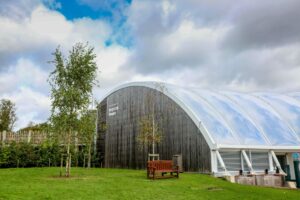Tropical House
Visit a lush rainforest in the Tropical House, where colourful birds fly overhead and you may come face-to-face with a Linne’s two-toed sloth!
Guest notice: In order to ensure we continue to keep our birds as safe as possible, we are asking people to use foot baths and sanitise their hands when entering this area.
This innovative and sustainable exhibit marks the second phase of a £17m investment programme over the next eight-ten years, creating improved habitats for animals and more immersive experiences for our guests.
Spanning two levels with fantastic vantage points, guests can experience face-to-face encounters with a diversity of wildlife and exotic plants in a tropical climate, while learning about the flow of energy through life.
Listen to the calls of the yellow-throated frogs below a cascading waterfall, admire the Linné’s two-toed sloth in the lush forest canopy and spot birds darting over the exhibit’s impressive 70,000-litre aquarium, which is home to more than 2,500 fish.
Tropical free-flying birds include crested wood partridge, Sclater’s crowned pigeon, white-naped pheasant pigeon, Nicobar pigeon, Brazilian tanager, Asian glossy starlings, and Fischer’s turaco.
Meanwhile the bustling forest floor is home to Burmese mountain tortoises and insects such as lesser goliath beetles. The Tropical House is also home to a crocodile monitor lizard and a colony of leaf-cutter ants.
Supported by a £1.5million Local Growth Fund (LGF) investment by Enterprise M3 Local Enterprise Partnership (LEP), the £8m exhibit will help us achieve our goal of becoming carbon-neutral by 2022.
Leading the way in sustainability, we realised a significant untapped energy resource in some of our 700 tonnes of animal waste (dung, soiled bedding and leftover hay) that could be used for renewable energy within the zoo.
The groundbreaking project features a woodchip boiler that will be supplemented by a specialist boiler capable of burning straw-based animal manure.
This will provide heating for buildings across the zoo and enable us to reduce our carbon footprint and dependency on fossil fuels.
The contemporary curved roof is built using the latest ETFE (ethylene tetrafluoroethylene) technology. This insulating roof canopy allows natural light to shine through, creating ideal conditions for 650 individual plants from 65 different species to flourish and form a lush habitat for the animals. Meanwhile, rainwater from the roof is harvested in two 50,000-litre tanks to provide water inside for the aquaria and plant watering, making the building totally self-sufficient.
This unique combination of visitor experience and sustainability creates a compelling interpretation story and educational opportunities for ‘Energy for Life’ Tropical House.
Through the Tropical House experience, we hope to encourage interest and understanding of the flow of energy through life, raise awareness of how the energy we need to power our modern lifestyles is generated and the consequences for the global environment. The exhibit highlights our changing climate, the measures we are taking to reduce carbon emissions and how our guests can make a difference.




